Gulyás, which is a soup not a stew, is probably the best known Hungarian dish, even though other nations, the Slovaks, Czechs, and Austrians, have their own versions of it. Interestingly enough, ”In the United States, someone decided that elbow macaroni with ground beef and tomatoes could also be called gulyas (although the innovator changed the spelling to goulash).” – writes Nicolaus Balla and Corthney Burns in Bar Tartine: Techniques & Recipes.
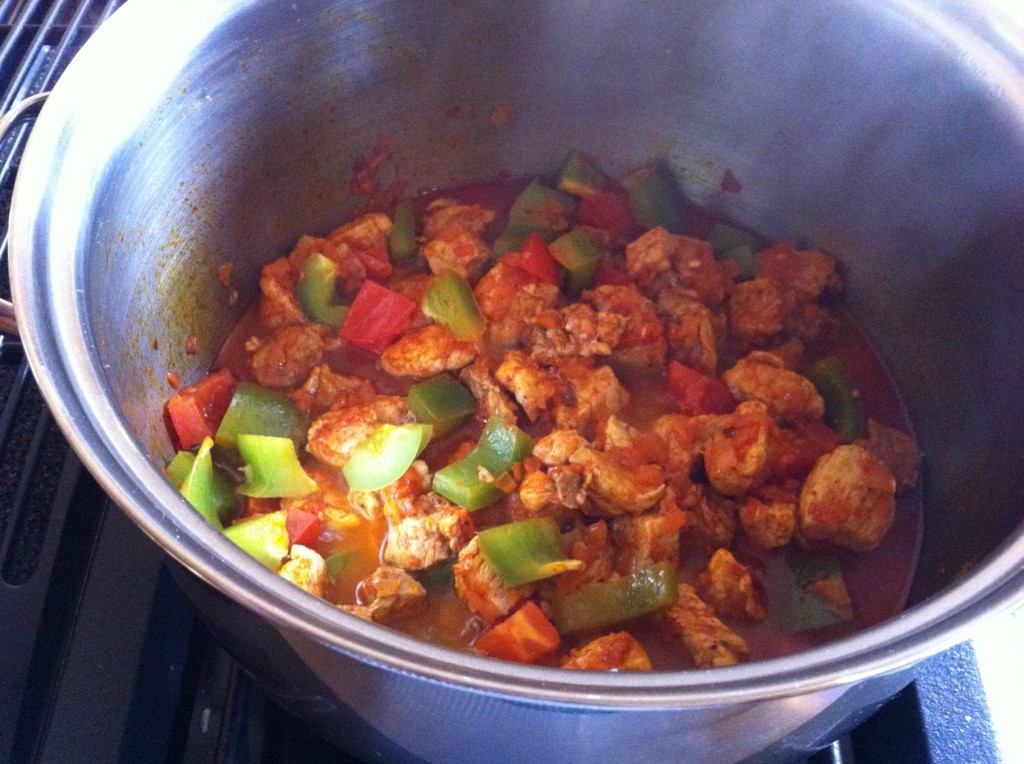
In Hungarian, gulyás originally meant an occupation, a herdsman, and only later started to mean the meat which was cooked by the herdsmen, traditionally in a cast-iron kettle over an open fire. Today, the word gulyás means both. For a long time, it was a peasant dish, but in the end of the 19th century it started to show up in the dining rooms of the wealthy. Most often it is made from beef (neck or shoulder), but it’s also wonderful from pork (shoulder or leg) and game (for example wild pig). There exist many different versions of gulyás, and each has its supporters. All agree that a good amount of meat and potatoes should be used, and under no conditions should flour be added to thicken it.
To cook gulyás we start with pörkölt, then add carrots, parsnips, potatoes, and water. The spices I always use are sweet paprika, salt, and caraway seed, but others might add crushed garlic and ground black pepper too. Sometimes the soup is made richer by adding small pasta pieces called csipetke – made from flour, egg, and salt – close to the end of cooking. We can also cook with less water and bigger pieces of potatoes leaving out the carrots and parsnips, and in this way, we make a stew, not a soup. I think it is a must to serve gulyás with a country-style bread. For those who love spicy food, chili pepper can be offered.
for the pörkölt
olive oil or lard – 1 tablespoon
medium onion – 1
sweet Hungarian ground paprika – 1 teaspoon
beef or pork – 1 lb
tomato – 1
medium bell pepper – 1
salt – to taste
other ingredients
carrots and parsnips – ½ lb total
potatoes – ¾ – 1 lb
caraway seeds – 2 teaspoons
First make the pörkölt. Cut the meat into 1-1½ -inch cubes, and finely chop the onions. Remove the seeds and ribs from the bell pepper, cut it into rounds, and cut the tomato into wedges, or cut both into small pieces. Heat the oil in a heavy-bottomed pot over medium heat, add the onions, and sauté, stirring occasionally, until soft and translucent, about 8-10 minutes. Remove from the heat, stir in the paprika until the onions are well coated, then add the meat. Put the pot back on the stove, set the heat high, and stir the meat continuously for about 2 minutes. Turn the heat to low. Season generously with salt, then add the tomato and the pepper. Cover, and cook gently, stirring occasionally, until the meat is almost tender, about 1-1½ hours.
In the meantime, clean the vegetables – slice the carrots and parsnips into rounds, cut the potatoes into small cubes. Add to the meat, stir it, cook for a few minutes, and then add about 6 cups of water and the caraway seeds. Cook until the vegetables and the meat are tender. If needed, adjust the seasoning. The soup is enough for 4 and is best served hot.
A gulyás, vagy pontosabban gulyásleves, talán a legismertebb magyar étel, de természetesen más nemzeteknek, például a cseheknek, szlovákoknak, osztrákoknak is megvan a saját változatuk. Nemrég olvastam egy érdekességet a Bar Tartine című amerikai szakácskönyvben ezzel kapcsolatban. A szerzők azt írják, hogy Amerikában valaki úgy határozott, makaróni, darált marhahús és paradicsom egyvelege is gulyás, bár az illető goulash-ra változtatta a szó írásmódját.
A magyar nyelvben a gulyás szó eredetileg a foglalkozást jelentette, később a gulyáshúst is (amit bográcsban, nyílt tűzön főztek a gulyások), manapság mindkettőt. A gulyásleves sokáig paraszti ételnek számított, de a 19. század végén a módosabbak asztalán is kezdett megjelenni. Leggyakrabban marhahúsból (lábszárból vagy nyakhúsból) készül, de sertéshúsból (combból) és vadhúsból (pl. vaddisznóból) is finom. Sokféle módon főzhetjük, s minden változatnak megvannak a hívei, azzal azonban mindenki egyetért, hogy nem szabad fukarkodni sem a hússal, sem a krumplival, és semmiképp sem szabad liszttel sűríteni a gulyás levét.
A gulyásfőzés a klasszikus pörköltből indul, majd a megpirított marhahúshoz adjuk a zöldségeket, fűszereket és a vizet. Van aki a pirospaprikán, són és köménymagon túl zúzott fokhagymát és őrölt fekete borsot is használ. A gulyást csipetkével – lisztből, tojásból és sóból készült picurka tésztával – is dúsíthatjuk, amit csak a legvégén adunk a leveshez, mert ez néhány perc alatt megfő. Ha kevesebb vízzel és több, nagyobb hasábokra szeletelt krumplival készítjük az ételt és a répaféléket is kihagyjuk, akkor gulyásleves helyett gulyást főzünk. Van aki csípős cseresznyepaprikával szereti. Tálaláskor elengedhetetlen a jó minőségű parasztkenyér.
a pörkölthöz
olaj vagy zsír– 1 evőkanál
közepes fej hagyma – 1
pirospaprika – 1 teáskanál
marha- vagy sertéshús – 400-450 g
paradicsom – 1
zöldpaprika – 1
só – ízlés szerint
más hozzávalók
sárgarépa és fehérrépa vegyesen – 200 g
burgonya – 300-400 g
köménymag – 2 teáskanál
Elkészítjük a pörköltet. A húst 2-3 cm-es kockákra, a hagymát finomra vágjuk. A zöldpaprikából kivágjuk az erét és a magházát, majd felkarikázzuk, a paradicsomot pedig cikkekre vágjuk. Egy nagy fazékban az olajon üvegesre fonnyasztjuk a hagymát. Lehúzzuk a tűzről, megszórjuk pirospaprikával, jól elkeverjük és azonnal rádobjuk a húst. Visszatesszük a tűzre és nagy lángon, állandóan kevergetve, hirtelen megpirítjuk. Mérsékeljük a tüzet. A húst ízlés szerint sózzuk, hozzátesszük a paradicsomot és a zöldpaprikát, s fedő alatt, mérsékelt tűzön (kb. másfél óra alatt), majdnem puhára pároljuk.
Közben megtisztítjuk a zöldségeket – a répaféléket felkarikázzuk, a burgonyát apró kockákra vágjuk. A húshoz adjuk, néhány percig együtt pároljuk, majd felöntjük kb. másfél liternyi vízzel. Beletesszük a köménymagot. Felforraljuk, majd lefedve lassú tűzön addig főzzük, amíg minden benne levő zöldség és hús meg nem puhul. Szükség szerint utánasózzuk. A leves 4 személynek bőven elég, forrón a legjobb.

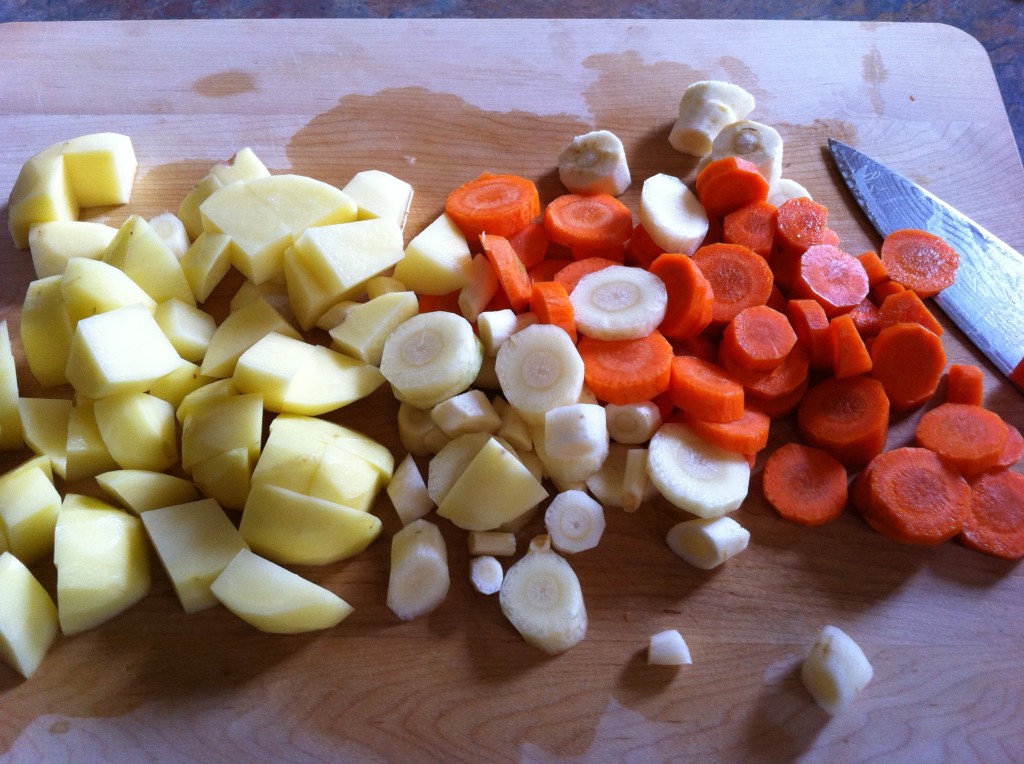
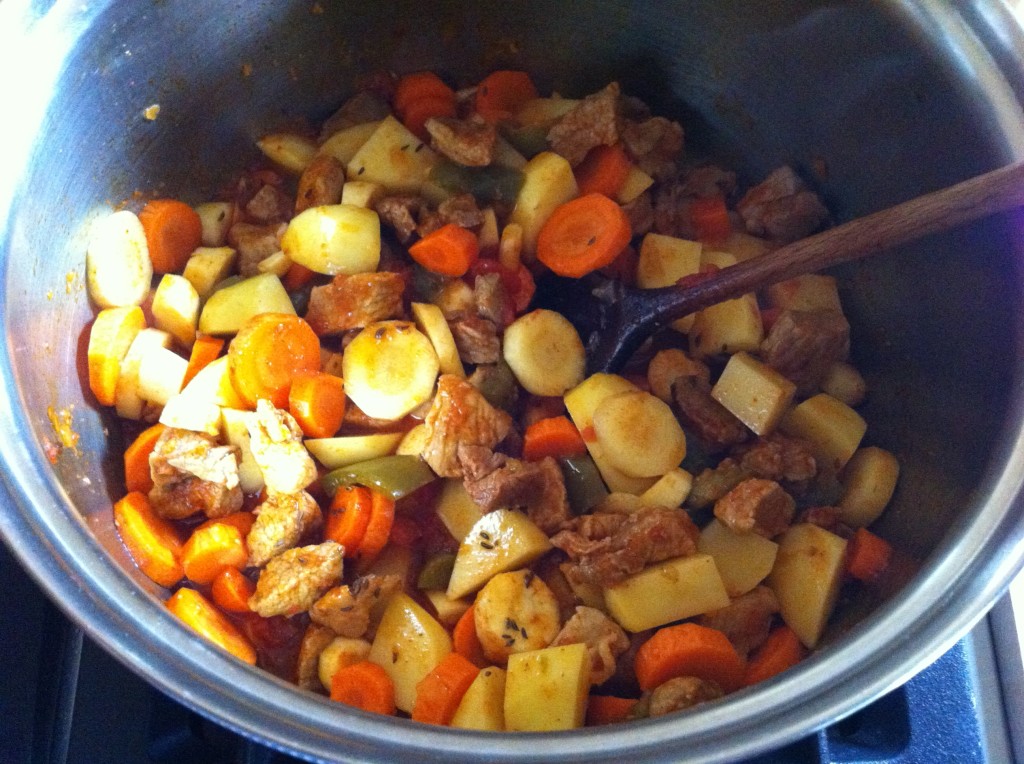
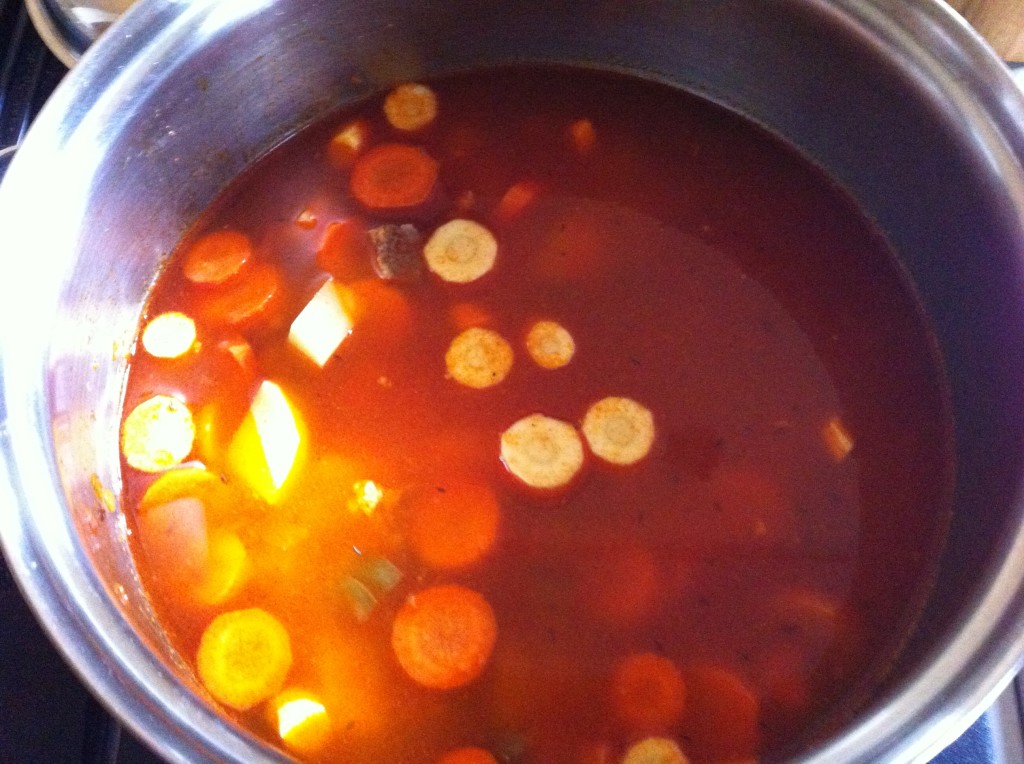
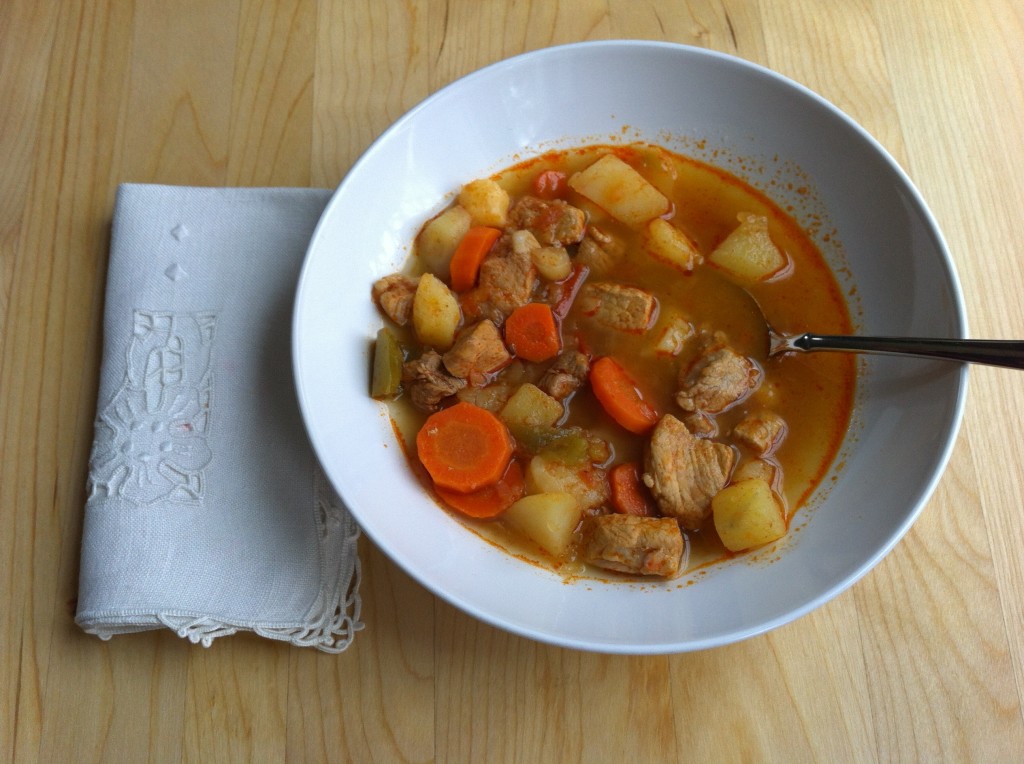
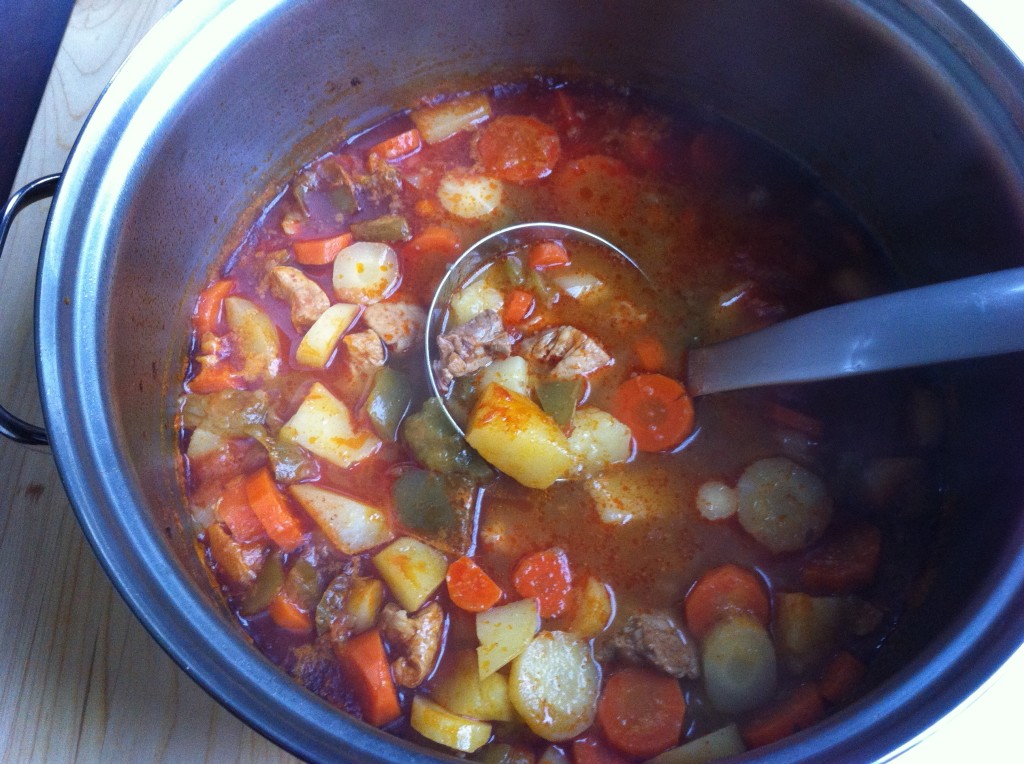






Yes, please! Sounds so perfect for the weather we’re having.
Yes, it’s definitely a comfort food. And it can please equally a small or a large group of people.